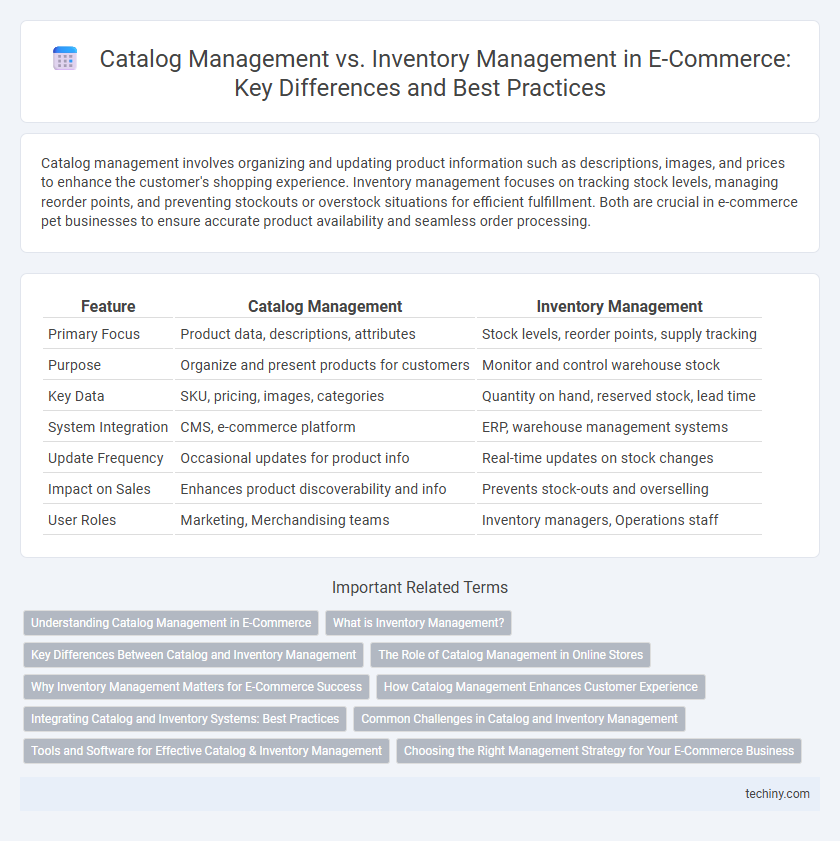Catalog management involves organizing and updating product information such as descriptions, images, and prices to enhance the customer's shopping experience. Inventory management focuses on tracking stock levels, managing reorder points, and preventing stockouts or overstock situations for efficient fulfillment. Both are crucial in e-commerce pet businesses to ensure accurate product availability and seamless order processing.
Table of Comparison
| Feature | Catalog Management | Inventory Management |
|---|---|---|
| Primary Focus | Product data, descriptions, attributes | Stock levels, reorder points, supply tracking |
| Purpose | Organize and present products for customers | Monitor and control warehouse stock |
| Key Data | SKU, pricing, images, categories | Quantity on hand, reserved stock, lead time |
| System Integration | CMS, e-commerce platform | ERP, warehouse management systems |
| Update Frequency | Occasional updates for product info | Real-time updates on stock changes |
| Impact on Sales | Enhances product discoverability and info | Prevents stock-outs and overselling |
| User Roles | Marketing, Merchandising teams | Inventory managers, Operations staff |
Understanding Catalog Management in E-Commerce
Catalog management in e-commerce involves organizing and maintaining detailed product information, including descriptions, images, categories, and specifications, to enhance the shopping experience and support accurate search results. It ensures consistent product data across multiple sales channels, facilitating efficient product discovery and seamless updates. Effective catalog management improves customer engagement and drives higher conversion rates by providing clear and comprehensive product insights.
What is Inventory Management?
Inventory management in e-commerce involves tracking and controlling stock levels to ensure products are available for customer orders without overstocking or stockouts. It uses real-time data and automated systems to monitor product quantities, manage reorder points, and forecast demand effectively. Efficient inventory management improves order fulfillment speed, reduces carrying costs, and enhances customer satisfaction by preventing delays.
Key Differences Between Catalog and Inventory Management
Catalog management focuses on organizing and maintaining product information such as descriptions, images, and specifications to enhance customer experience and streamline product discovery. Inventory management tracks stock levels, manages reorder processes, and monitors product availability to prevent stockouts and overstock situations. While catalog management optimizes product presentation, inventory management ensures operational efficiency and accurate fulfillment in e-commerce.
The Role of Catalog Management in Online Stores
Catalog management in online stores involves organizing, categorizing, and presenting product information to enhance customer experience and searchability. It ensures accurate product descriptions, images, pricing, and specifications, which directly impact conversion rates and SEO performance. Effective catalog management supports seamless integration with inventory management by providing real-time product data that drives stock availability and order fulfillment accuracy.
Why Inventory Management Matters for E-Commerce Success
Inventory management ensures real-time stock accuracy, preventing overselling and stockouts that can damage customer trust and reduce sales. Effective inventory control optimizes order fulfillment speed and reduces holding costs, directly impacting profitability and customer satisfaction. Unlike catalog management, which focuses on product information and categorization, inventory management is critical for operational efficiency and maintaining competitive advantage in e-commerce.
How Catalog Management Enhances Customer Experience
Catalog management enhances customer experience by providing a well-organized, easily navigable product listing with detailed descriptions, high-quality images, and accurate pricing information. This streamlined presentation enables shoppers to quickly find and compare products, reducing decision fatigue and increasing satisfaction. Consistent updates in catalog management ensure that customers see the latest product offerings and promotions, fostering trust and repeat business.
Integrating Catalog and Inventory Systems: Best Practices
Integrating catalog and inventory systems enhances e-commerce efficiency by ensuring real-time synchronization of product data and stock levels, reducing errors and improving customer experience. Best practices include using API-driven platforms for seamless data exchange, implementing centralized dashboards for unified management, and automating updates to reflect inventory changes instantly. Leveraging scalable cloud-based solutions supports dynamic catalog expansion and accurate inventory tracking, driving operational agility and sales growth.
Common Challenges in Catalog and Inventory Management
Common challenges in catalog and inventory management include maintaining accurate product information and real-time stock levels across multiple sales channels. Ensuring consistency in product descriptions, pricing, and categorization while preventing overselling requires effective synchronization between catalog databases and inventory systems. Data discrepancies and integration issues often lead to order fulfillment delays and customer dissatisfaction in e-commerce operations.
Tools and Software for Effective Catalog & Inventory Management
Effective e-commerce operations rely on specialized tools for catalog management such as Shopify, Magento, and BigCommerce, which streamline product listing, categorization, and attribute updates. Inventory management software like TradeGecko, Zoho Inventory, and NetSuite provide real-time stock tracking, demand forecasting, and order fulfillment automation. Integrating these platforms enhances accuracy, reduces stockouts, and ensures seamless synchronization between online catalogs and warehouse inventories.
Choosing the Right Management Strategy for Your E-Commerce Business
Effective catalog management organizes product information, descriptions, and pricing to enhance customer experience and streamline searchability. Inventory management tracks stock levels, orders, and supply chain logistics to prevent stockouts or overstock situations, ensuring operational efficiency. Selecting the right strategy depends on your e-commerce business scale--prioritize catalog management for extensive product ranges and emphasize inventory management when maintaining real-time stock accuracy is critical.
Catalog Management vs Inventory Management Infographic

 techiny.com
techiny.com